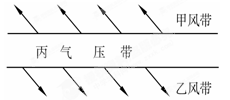问题
选择题
读“全球近地面气压带和风带”局部示意图,完成题。

小题1:图中的“丙气压带”是指( )
A.赤道低气压带
B.副热带高气压带
C.极地高气压带
D.副极地低气压带小题2:根据图中信息,说法正确的是( )
A.受丙气压带影响,撒哈拉沙漠炎热少雨
B.受甲风带移动影响,南亚地区6--9月多雨
C.受乙风带影响,西欧地区全年温和湿润
D.受丙气压带和乙风带交替控制,新西兰形成地中海气候
答案
小题1:B
小题2:B
题目分析:
小题1:根据图示气压带和风带的分布规律和甲乙两风带的风向,可判定丙为高压带,且两侧的风向不同,故判断为副热带高压带,且风向向左偏,判断丙是南半球的副热带高气压带。
小题2:结合上题结论,撒哈拉沙漠位于北半球,其热带沙漠是由于终年受副热带高压带或东北信风带控制而形成,A错误;甲风带为南半球的东南信风带;南亚的夏季风成因是由于全球气压带风带的移动,北半球夏季,南半球的东南信风越过赤道,受地转偏向力向右偏影响,则形成西南季风,故B正确;西欧位于北半球,而乙风带为南半球的盛行西风带,C错误;新西兰为温带海洋性气候,D错误。
点评:本题难度一般,学生只要掌握全球气压带风带的分布和移动规律,风向的判断方法:根据地转偏向力的不同偏向判断南北半球;并结合南亚夏季西南季风的成因分析和世界气候类型分布和成因的判断。
